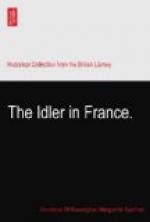The arches rest on plain pilasters, with capitals more resembling the Doric than any other order of architecture. On the keystone of each arch is the mark of a youthful male head, surmounted by two wings. The four angles of the first stage are finished by a fluted column, with a capital charmingly executed, like, but not quite, the Corinthian. These columns sustain an entablature or two, which terminate this stage, and its frieze is enriched with sculpture representing winged sea-monsters and sirens with sacrificial instruments.
Above the first stage rises the second, which is of a round form, with ten fluted columns, which support its circular entablature; the capitals of these columns are similar to those of the first stage, and the frieze is ornamented with foliage delicately sculptured.
A round cupola terminates this building, through which the light shines in on every side, although two male statues in togas occupy the centre of it.
To view the height at which these figures are placed, one would suppose they were safe from the attacks of the mischievous or the curious; nevertheless, they did not escape, for, many years ago, during the night, their heads were taken off, and those that replaced them reflect little credit on the taste or skill of the modern sculptor who executed the task.
On the architrave of the entablature of the first stage, and on the north front, is the following inscription:—
SEX. L. M. JVLIEI. C.F. PARENTIBUS. SVEIS.
Various are the opinions given by the writers who have noticed this monument as to the cause for which, and person, or persons for whom, it was erected. Some maintain that the triumphal arch from its vicinity has a relation to the mausoleum, while others assert them to have been built at different epochs.
The inscription has only served to base the different hypotheses of antiquaries, among which that of the Abbe Barthelemy is considered the most probable; namely, that in the three first words are found two initials, which he considers may be rendered as follows:—
SEXTUS . LUCIVS . MARCVS;
and the two other initials, C.F., which follow the word JVLIEI, may be explained in the same manner to signify Caii Filii, and, being joined to Juliei, which precedes, may be received to mean Julii Caii Filii.
Mantour’s reading of the inscription is, Caius Sextius Lucius, Maritus JULIAE Incomparabilis, Curavit Fieri PARENTIBUS SUIS; which he translates into Caius Sextius Lucius, Husband of Julia, caused this Monument to be erected to the Memory of his Ancestors, and the victories achieved by them in Provence, which on different occasions had been the theatre of war of the Romans.
Bouche’s version of it is,—
{Lucius, }
Sextus {Laelius, } Maritus Juliae.
{Liberius,}
Istud Cenotaphium,}
or, } Fecit Parentibus Suis;
Intra Circulum, }




